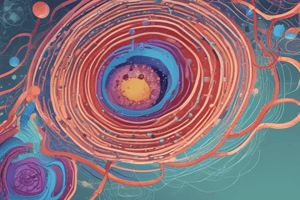Podcast
Questions and Answers
The nuclear envelope is a solid barrier that prevents the movement of molecules between the nucleus and the cytoplasm.
The nuclear envelope is a solid barrier that prevents the movement of molecules between the nucleus and the cytoplasm.
False (B)
What are the specific signals on proteins destined for the nucleus called?
What are the specific signals on proteins destined for the nucleus called?
Nuclear localization signals (NLS)
Which of the following is NOT a component of the nuclear pore complex?
Which of the following is NOT a component of the nuclear pore complex?
- Ribosomes (correct)
- Exportins
- Nuclear localization signals (NLS)
- Importins
The process of moving molecules from the nucleus to the cytoplasm is called ______.
The process of moving molecules from the nucleus to the cytoplasm is called ______.
Match the following components to their function in nuclear transport:
Match the following components to their function in nuclear transport:
Explain how the nuclear transport system ensures selectivity.
Explain how the nuclear transport system ensures selectivity.
Dysfunction in nuclear transport proteins can contribute to the development of diseases like cancer and neurodegenerative disorders.
Dysfunction in nuclear transport proteins can contribute to the development of diseases like cancer and neurodegenerative disorders.
What is the primary source of energy for nuclear transport?
What is the primary source of energy for nuclear transport?
Flashcards
Nuclear-Cytoplasmic Transport
Nuclear-Cytoplasmic Transport
Bidirectional movement of molecules between the nucleus and cytoplasm.
Nuclear Envelope
Nuclear Envelope
Double membrane structure that separates the nucleus from the cytoplasm.
Nuclear Pores
Nuclear Pores
Complex structures that span the nuclear envelope for selective transport.
Importins
Importins
Signup and view all the flashcards
Exportins
Exportins
Signup and view all the flashcards
Energy Dependency
Energy Dependency
Signup and view all the flashcards
Nuclear Transport Regulation
Nuclear Transport Regulation
Signup and view all the flashcards
Nuclear Pore Complex (NPC)
Nuclear Pore Complex (NPC)
Signup and view all the flashcards
Study Notes
Nuclear-Cytoplasmic Transport
- Nuclear-cytoplasmic transport is the bidirectional movement of molecules between the nucleus and the cytoplasm, a crucial process for cellular function.
- The nuclear envelope, a double membrane structure, separates the nucleus from the cytoplasm. Notably, it isn't a solid barrier, but a network of pores facilitating selective transport.
- Nuclear pores are large, complex structures traversing the nuclear envelope. They act as gateways for the regulated trafficking of molecules, including proteins, RNA, and other biomolecules.
- Proteins destined for the nucleus contain specific signals, nuclear localization signals (NLS), recognized by importin receptors. Importins bind to NLS and guide the cargo through the pore complex.
- Importin-cargo complexes bind to the cytosolic fibrils of the nuclear pore complex. Energy-dependent transport, likely involving conformational changes in importin proteins, occurs. Importins are released from cargo in the nucleus, where they are recycled back to the cytosol.
- Export of molecules from the nucleus, such as mRNA and ribosomal subunits, requires export receptors, like exportins, that recognize specific export signals.
- Similar to import, the export process uses energy from ATP hydrolysis and involves interactions with nuclear pore complex components.
- Nuclear transport mechanisms are highly regulated. Proteins can have multiple signals and interactions affecting their entry or exit. These mechanisms control gene expression, maintain cellular balance, and perform many other critical processes.
- Dysfunction in nuclear transport proteins can lead to various diseases, including neurological and genetic disorders.
- The selectivity of nuclear transport is crucial. The system efficiently transmits necessary molecules while confining others to the correct compartment.
- Small molecules (e.g., amino acids, nucleotides) traverse the nuclear envelope passively through the aqueous pores, while larger molecules require specific receptors and energy.
- The nuclear pore complex (NPC) is a dynamic and adaptable structure. The regulation and efficiency of protein import and export are not fully understood, but research focuses on these complex interactions.
- Numerous proteins, including importins, exportins, and various NPC components, are involved in nuclear transport.
- These transport mechanisms are essential for cellular processes like gene expression, DNA replication, and ribosome synthesis, facilitating intricate information and resource exchange between the nucleus and cytoplasm.
- The overall process is essential for cellular function and regulates cellular activities.
Studying That Suits You
Use AI to generate personalized quizzes and flashcards to suit your learning preferences.




